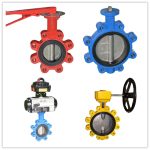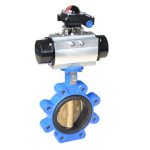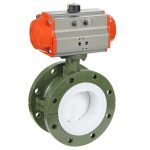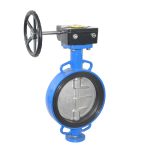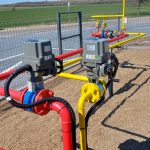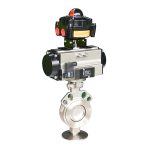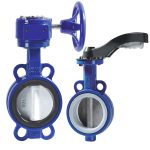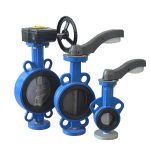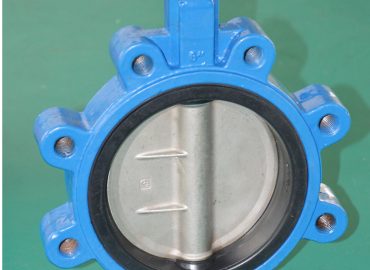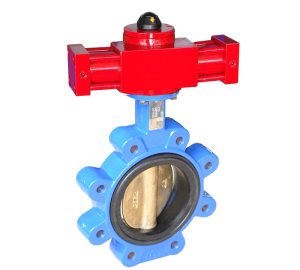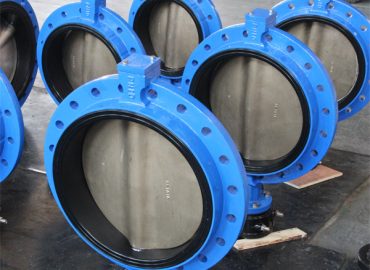Butterfly valves play a crucial role in controlling the flow of liquids and gases in various industrial applications. As such, selecting the right butterfly valve part is essential to ensure optimal performance, reliability, and safety. This process involves considering several factors, including the type of butterfly valve, material compatibility, size and pressure rating, actuation method, seat design and sealing, industry standards and certifications, as well as manufacturer reputation and support. In this blog post, we’ll delve into these important aspects to help you make an informed decision when choosing the most suitable butterfly valve part for your specific needs.
Introduction
Selecting the most appropriate butterfly valve part is a critical aspect of ensuring optimal performance and reliability in various industrial applications. There are several key factors to consider during this selection process. First and foremost, it’s essential to understand the different types of butterfly valves, such as concentric, double eccentric, and triple eccentric, as each type is designed for specific applications and conditions. Material compatibility is another crucial aspect; selecting the right materials for the valve parts, including the body, disc, stem, and seat, is vital to ensure corrosion resistance, temperature limits, and chemical compatibility. Additionally, choosing the correct size and pressure rating based on system requirements is critical for proper functioning. The actuation method, whether manual, electric, pneumatic, or hydraulic, should also be carefully considered, taking into account factors such as speed, torque, and control requirements. Seat design and sealing play a significant role in a butterfly valve’s performance, with various designs available, such as resilient seated, high-performance, and metal seated, each offering distinct benefits. It’s important to consider factors like leakage rate, temperature range, and service life when selecting the right seat design. Adherence to industry standards and certifications, like API, ASME, ISO, and CE, is essential to ensure quality, safety, and reliability. Lastly, selecting a reputable manufacturer with a proven track record and reliable after-sales support is vital for long-term satisfaction with your butterfly valve parts. By carefully considering all these aspects, you can make an informed decision and choose the most suitable butterfly valve part for your specific application.
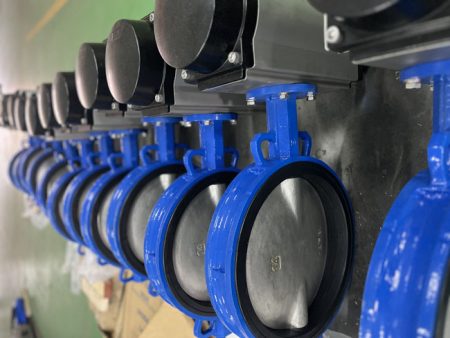
Briefly explain what a butterfly valve is
A butterfly valve is a type of flow control device commonly used in various industrial applications to regulate or isolate the flow of liquids, gases, and semi-solids. The valve consists of a circular disc mounted on a rotating shaft, which functions as the closing mechanism. When the disc is rotated, it either opens or closes the passageway, allowing or restricting the flow of the medium. Butterfly valves are known for their compact design, ease of operation, and cost-effectiveness, making them a popular choice for many industries, such as water treatment, chemical processing, food and beverage, and oil and gas.
Importance of selecting the right butterfly valve part for various applications
Selecting the right wafer butterfly valve part is of paramount importance for ensuring optimal performance, durability, and safety in various applications. The appropriate valve components not only affect the valve’s ability to regulate and isolate flow effectively but also determine its compatibility with specific media and operating conditions. By choosing the correct butterfly valve part, you can minimize the risk of leaks, corrosion, and premature wear, ultimately extending the valve’s service life and reducing maintenance costs. Furthermore, selecting the appropriate valve components enhances overall system efficiency and reliability, contributing to a smoother operation and minimizing downtime. Therefore, understanding the unique requirements of each application and carefully considering factors such as material compatibility, size, pressure rating, and actuation method is essential when selecting the ideal butterfly valve part.
Type of butterfly valve
Butterfly valves come in various types, each designed to cater to specific applications and operating conditions. The three primary types of butterfly valves are concentric, double eccentric, and triple eccentric. Concentric butterfly valves, also known as rubber-lined or resilient-seated valves, feature a central disc that rotates around a fixed axis. These valves are suitable for low-pressure applications and provide bi-directional sealing at an affordable cost. They are commonly used in water treatment, HVAC systems, and other general-purpose applications. Double eccentric butterfly valves, often referred to as high-performance valves, have an offset stem and disc design, which reduces friction between the disc and seat during operation. This design allows for improved sealing capabilities and longer service life, making them ideal for higher pressure and temperature applications, such as those found in the oil and gas industry. Triple eccentric butterfly valves, also known as metal-seated or triple offset valves, feature a unique design with three distinct offsets: one for the shaft, one for the disc, and one for the seat. This configuration enables the valve to provide tight shut-off and excellent sealing performance even under extreme temperatures and pressures. Triple eccentric valves are commonly used in demanding applications, such as power generation, petrochemical processing, and cryogenic services. Understanding the distinct features and capabilities of each butterfly valve type is essential for selecting the most suitable valve for your specific application, ensuring optimal performance, reliability, and longevity.

Discuss different types of butterfly valves (e.g., concentric, double eccentric, triple eccentric)
Wafer Butterfly valves are available in various types, each designed to cater to specific applications and operating conditions. The three main types include concentric, double eccentric, and triple eccentric butterfly valves. Concentric butterfly valves, also known as rubber-lined or resilient-seated valves, have a disc that rotates around a central axis, making them suitable for low-pressure applications such as water treatment and HVAC systems. Double eccentric butterfly valves, often referred to as high-performance valves, feature an offset stem and disc design that reduces friction between the disc and seat during operation, resulting in improved sealing capabilities and longer service life. These valves are ideal for higher pressure and temperature applications, commonly found in the oil and gas industry. Lastly, triple eccentric butterfly valves, also known as metal-seated or triple offset valves, boast a unique design with three distinct offsets that enable tight shut-off and excellent sealing performance, even under extreme temperatures and pressures. These valves are typically used in demanding applications such as power generation, petrochemical processing, and cryogenic services. By understanding the different types of butterfly valves and their respective features, you can select the most appropriate valve for your specific application, ensuring optimal performance and reliability.
Explain how each type is suited for specific applications and conditions
Each type of lug butterfly valve is uniquely designed to cater to specific applications and conditions, providing optimal performance and reliability. Concentric butterfly valves, with their central disc rotation and resilient seating, are ideal for low-pressure applications where bi-directional sealing is required, such as water treatment plants, HVAC systems, and other general-purpose uses. Double eccentric butterfly valves, featuring an offset stem and disc design, are better suited for higher pressure and temperature scenarios, as they minimize friction between the disc and seat, enhancing sealing capabilities and service life. These valves are commonly used in industries like oil and gas, where more demanding conditions prevail. Triple eccentric butterfly valves, with their distinctive three-offset design, excel in extreme temperatures and pressures, offering tight shut-off and superior sealing performance. They are particularly suited for high-demand applications, such as power generation, petrochemical processing, and cryogenic services. By understanding the unique characteristics of each butterfly valve type, you can select the most suitable option for your specific application, ensuring efficient operation and long-term reliability.
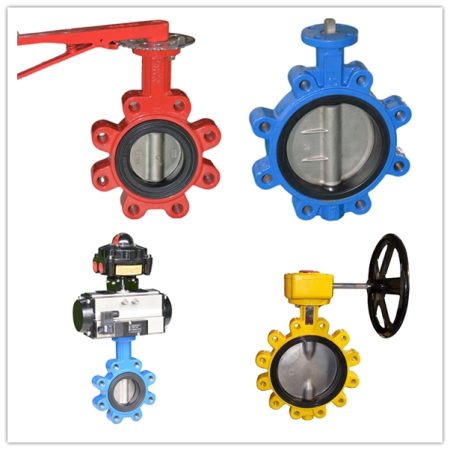
Material compatibility
Material compatibility is a crucial factor to consider when selecting components for various industrial applications, including butterfly valves. The materials used in the construction of valve components, such as the body, disc, stem, and seat, play a vital role in determining the valve’s overall performance, durability, and resistance to corrosion and wear. It is essential to choose materials that are compatible with the specific media and operating conditions to which the valve will be exposed. Factors such as temperature, pressure, and chemical composition of the medium must be taken into account when determining material compatibility. Common materials used in butterfly valves include stainless steel, carbon steel, bronze, and various plastic and elastomer materials for seats and seals. Stainless steel is known for its excellent corrosion resistance and is suitable for a wide range of applications, while carbon steel offers high strength at a lower cost but may require additional protection against corrosion. Bronze is often used for its good corrosion resistance and compatibility with various media, particularly in seawater applications. Plastic and elastomer materials, such as PTFE, EPDM, and NBR, offer excellent chemical resistance and flexibility, making them ideal for seats and seals in various applications. By carefully considering material compatibility, you can ensure that your butterfly valve will perform optimally and withstand the demands of your specific application, leading to increased reliability, reduced maintenance costs, and an extended service life.
Importance of choosing the right material for the valve parts (e.g., body, disc, stem, seat)
Choosing the right material for valve parts, such as the body, disc, stem, and seat, is crucial for ensuring optimal performance, durability, and resistance to corrosion and wear in various industrial applications. The appropriate materials not only affect the valve’s overall functionality but also determine its compatibility with specific media and operating conditions. By selecting the correct materials, you minimize the risk of leaks, corrosion, and premature wear, ultimately extending the valve’s service life and reducing maintenance costs. Furthermore, the right material choices contribute to enhanced system efficiency and reliability, leading to smoother operation and minimized downtime. Therefore, it is essential to consider factors such as temperature, pressure, and chemical composition of the medium when determining the most suitable materials for your butterfly valve components. This careful consideration ensures that your valve meets the unique requirements of your application and performs effectively over time.
Discuss common materials used in butterfly valves (e.g., stainless steel, cast iron, bronze, plastic)
Butterfly valves are manufactured using various materials to cater to the diverse requirements of different applications and industries. Common materials used in butterfly valves include stainless steel, cast iron, bronze, and plastic. Stainless steel is a popular choice due to its excellent corrosion resistance, durability, and suitability for a wide range of applications, including those involving aggressive media or high temperatures. Cast iron, known for its cost-effectiveness and robustness, is commonly used in general-purpose applications with lower pressure ratings, such as water distribution and HVAC systems. Bronze is another material frequently used in butterfly valves due to its good corrosion resistance and compatibility with various media, making it particularly suitable for seawater applications or situations involving corrosive fluids. Finally, plastic materials, such as PVC, CPVC, and PP, provide excellent chemical resistance and lightweight construction, making them ideal for specific applications where corrosion resistance and weight reduction are essential, particularly in the chemical processing and wastewater treatment industries. By understanding the properties and advantages of these common materials, you can make informed decisions when selecting the most suitable butterfly valve components for your specific needs.
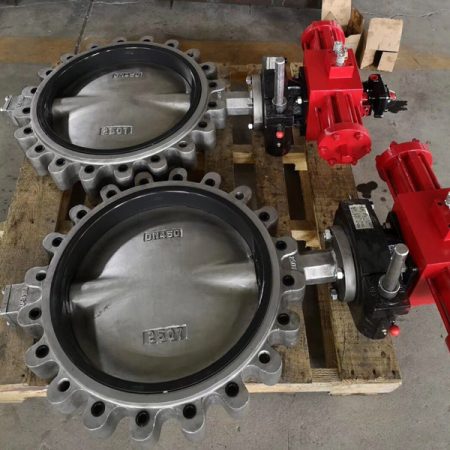
Considerations for corrosion resistance, temperature limits, and chemical compatibility
When selecting the appropriate materials for butterfly valve components, it is essential to consider factors such as corrosion resistance, temperature limits, and chemical compatibility to ensure optimal performance and durability in various applications. Corrosion resistance is crucial, as it determines the valve’s ability to withstand the effects of corrosive media and environmental conditions, ultimately affecting its service life and reliability. Temperature limits are another vital consideration, as materials must be able to withstand the range of temperatures associated with the specific application without compromising their structural integrity or performance. Chemical compatibility refers to the material’s ability to resist degradation or damage when exposed to various chemicals present in the media, which is critical for maintaining the valve’s functionality and preventing leaks, contamination, or system failure. By taking these factors into account when selecting materials for your butterfly valve components, you can ensure that your valve will perform effectively in your specific application, providing long-lasting, reliable operation and minimizing the need for maintenance or replacement.
Size and pressure rating
The size and pressure rating of butterfly valves are crucial factors to consider when selecting the right valve for a specific application, as they directly impact the valve’s performance, efficiency, and overall suitability for the intended use. The size of a butterfly valve, typically expressed in terms of its nominal diameter or pipe size, determines the flow capacity and consequently affects the fluid velocity and pressure drop across the valve. It is essential to choose an appropriately sized valve that can handle the required flow rate without causing excessive pressure loss or cavitation, which could lead to decreased system efficiency, noise, vibration, or even damage to the valve components.
Pressure rating, on the other hand, indicates the maximum pressure that a valve can safely withstand during operation. This rating is typically expressed in units such as pounds per square inch (psi) or bars and is determined by factors such as the material, design, and construction of the valve components. Selecting a butterfly valve with an appropriate pressure rating is critical for ensuring the valve’s ability to maintain its sealing integrity and structural stability under the specific operating conditions, thus preventing leaks, system failure, or safety hazards. Moreover, it is essential to account for potential pressure fluctuations or surges that may occur during normal operation or under adverse conditions, as these could exceed the valve’s pressure rating and compromise its performance or safety.
By carefully considering the size and pressure rating of a butterfly valve and selecting one that meets the unique requirements of your application, you can ensure efficient operation, optimal performance, and long-term reliability, ultimately contributing to the overall success of your project or process.
Importance of selecting the correct size and pressure rating for the application
Selecting the correct size and pressure rating for a butterfly valve is of paramount importance to ensure optimal performance, efficiency, and safety in any given application. An appropriately sized valve allows for the required flow rate without causing excessive pressure loss or cavitation, which could lead to decreased system efficiency, noise, vibration, or potential damage to the valve components. Similarly, choosing a valve with the appropriate pressure rating ensures that it can safely withstand the operating pressures, maintaining sealing integrity and structural stability, thus preventing leaks, system failure, or safety hazards. By taking into consideration factors such as the flow rate, temperature, and pressure fluctuations, and selecting the right size and pressure rating, you can guarantee the long-term reliability and efficient operation of your butterfly valve, ultimately contributing to the success and cost-effectiveness of your project or process.
Discuss how to determine the appropriate size and pressure rating based on system requirements
Determining the appropriate size and pressure rating for a butterfly valve based on system requirements involves careful consideration of several factors, including flow rate, operating pressure, temperature, and potential pressure fluctuations. To select the correct size, it is essential to know the required flow rate and fluid velocity to ensure that the valve can handle the demand without causing excessive pressure drop or cavitation. Consulting flow charts or sizing tables provided by valve manufacturers can be helpful in selecting the right valve size for your specific application.
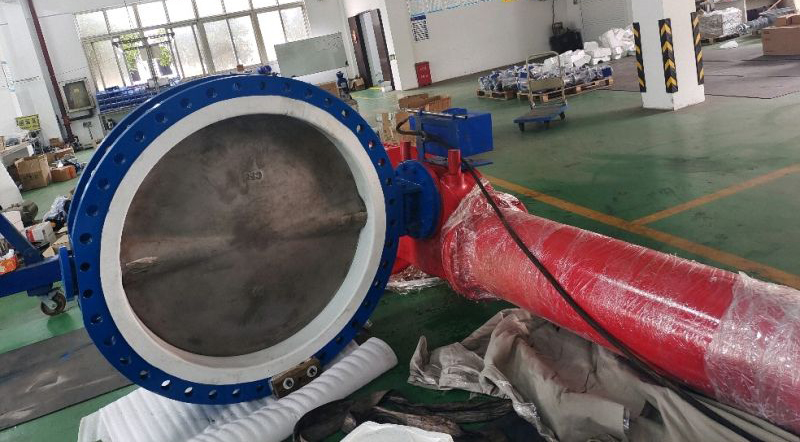
When it comes to pressure rating, evaluating the maximum operating pressure, as well as accounting for potential pressure surges or fluctuations, is crucial to ensure the valve’s structural stability and sealing integrity. It’s important to choose a valve with a pressure rating that exceeds the maximum anticipated system pressure to provide a safety margin and accommodate any unforeseen pressure variations. Additionally, consider the impact of temperature on both size and pressure rating, as temperature changes can affect material properties and consequently the valve’s performance.
By thoroughly analyzing system requirements and taking into account factors such as flow rate, operating pressure, temperature, and potential pressure fluctuations, you can accurately determine the appropriate size and pressure rating for your butterfly valve, ensuring optimal performance, long-term reliability, and overall success of your project or process.
Actuation method
The actuation method of a butterfly valve plays a crucial role in determining its functionality, control accuracy, and suitability for a particular application. Actuation methods can be broadly categorized into manual and automated types, each offering distinct advantages and limitations depending on the specific requirements of the system. Manual actuation, which typically involves the use of handwheels, levers, or gear operators, provides a cost-effective and straightforward solution for systems that do not require precise flow control or frequent adjustments. However, manual actuation may not be suitable for applications with hard-to-reach valves, high torque requirements, or those necessitating rapid response times.
Automated actuation, on the other hand, offers greater precision, responsiveness, and flexibility in controlling the valve’s operation. Automated actuators can be further classified into electric, pneumatic, and hydraulic types, each with their unique characteristics and advantages. Electric actuators are known for their energy efficiency, ease of installation, and compatibility with various control systems, making them ideal for a wide range of applications. Pneumatic actuators, driven by compressed air, provide fast response times, high torque output, and are often preferred in applications requiring explosion-proof or intrinsically safe solutions. Hydraulic actuators, which utilize pressurized fluid to generate motion, offer high force output and precise control, making them suitable for heavy-duty or high-pressure applications.
When selecting an actuation method for your butterfly valve, it is essential to consider factors such as the required level of control accuracy, response time, torque output, environmental conditions, and available power sources. By carefully evaluating these factors and choosing the most appropriate actuation method, you can ensure optimal performance, reliability, and efficiency for your specific application, ultimately contributing to the overall success of your project or process.
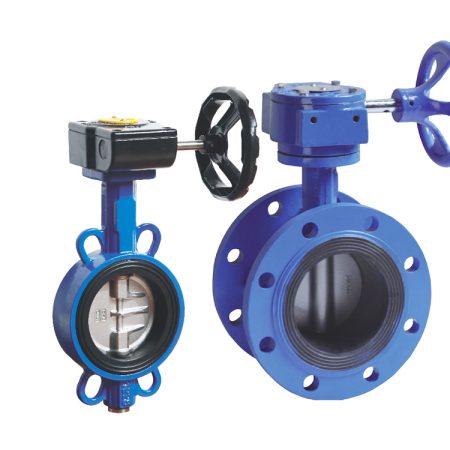
Different actuation methods available for butterfly valves (e.g., manual, electric, pneumatic, hydraulic)
Butterfly valves can be operated using various actuation methods, including manual, electric, pneumatic, and hydraulic, each offering specific advantages and suitability for different applications. Manual actuation, utilizing handwheels, levers, or gear operators, is a simple and cost-effective solution for systems that do not require precise flow control or frequent adjustments. Electric actuators offer energy efficiency, ease of installation, and compatibility with different control systems, making them a popular choice for a wide range of applications. Pneumatic actuators, driven by compressed air, provide fast response times, high torque output, and are often preferred in applications requiring explosion-proof or intrinsically safe solutions. Hydraulic actuators, which use pressurized fluid to generate motion, deliver high force output and precise control, making them suitable for heavy-duty or high-pressure applications. By understanding the unique characteristics and benefits of these different actuation methods, you can select the most appropriate option for your butterfly valve, ensuring optimal performance, reliability, and efficiency in your specific application.
Factors to consider when selecting an actuator, such as speed, torque, and control requirements
When selecting an actuator for a butterfly valve, it is essential to consider factors such as speed, torque, and control requirements to ensure optimal performance, reliability, and efficiency in your specific application. The actuator’s speed, or response time, determines how quickly the valve can open or close, which is particularly important in applications requiring rapid adjustments or emergency shut-off capabilities. Torque, or the rotational force generated by the actuator, must be sufficient to overcome the valve’s inherent resistance and any additional forces imposed by the process media, ensuring smooth and reliable operation. Control requirements refer to the level of precision and accuracy needed to regulate the flow through the valve, which can range from simple on-off control to modulating control for more complex processes. By carefully evaluating these factors and selecting an actuator that meets the unique demands of your system, you can achieve the desired level of control, responsiveness, and durability, ultimately contributing to the overall success and cost-effectiveness of your project or process.
Seat design and sealing
The seat design and sealing of a butterfly valve are critical factors that significantly impact the valve’s performance, reliability, and suitability for various applications. The primary function of the valve seat is to provide a reliable seal between the valve disc and the valve body, preventing leakage when the valve is in the closed position. Butterfly valve seats can be made from a variety of materials, including elastomers, polymers, and metals, each offering distinct advantages and limitations depending on the specific requirements of the system, such as temperature, pressure, and chemical compatibility.
Elastomeric seats, made from materials like EPDM, NBR, or Viton, offer excellent flexibility, resilience, and sealing capabilities, making them suitable for low to moderate pressure and temperature applications. However, they may not be ideal for high-temperature or aggressive chemical environments due to their limited thermal and chemical resistance. Polymer seats, such as PTFE or PEEK, provide enhanced chemical and temperature resistance compared to elastomers, ensuring a reliable seal across a broader range of operating conditions. Metal seats, typically made from stainless steel or other alloys, offer the highest level of durability and resistance to extreme temperatures and pressures but may not provide the same level of sealing tightness as elastomeric or polymer seats.
In addition to seat material, the seat design also plays a crucial role in determining the valve’s sealing performance. Common seat designs include resilient-seated, double-offset, and triple-offset valves. Resilient-seated valves feature a rubber or elastomeric seat that provides a tight, bi-directional seal, making them suitable for general-purpose applications. Double-offset valves, also known as high-performance butterfly valves, incorporate a slightly offset disc and stem design that reduces friction and wear on the seat, resulting in improved sealing performance and longer service life. Triple-offset valves, designed with three distinct offsets, provide exceptional sealing performance and reduced torque requirements, making them ideal for high-pressure, high-temperature, or critical applications.By carefully considering the seat design and sealing properties of a butterfly valve, you can select the most appropriate option that meets the unique requirements of your application, ensuring optimal performance, reliability, and overall success of your project or process.
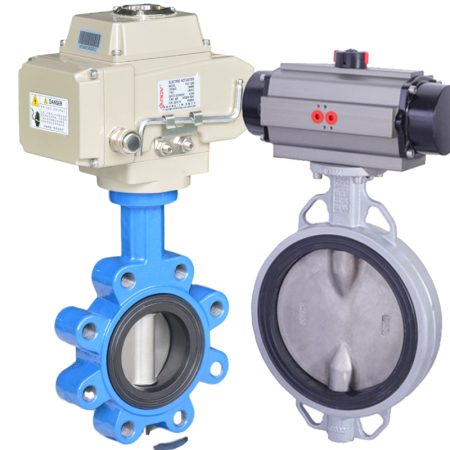
Explain the significance of seat design in butterfly valves
The significance of seat design in butterfly valves lies in its crucial role in determining the valve’s sealing performance, reliability, and suitability for specific applications. An effective seat design ensures a tight seal between the valve disc and body, preventing leakage and enabling precise flow control. Various seat designs, such as resilient-seated, double-offset, and triple-offset valves, cater to different operating conditions and requirements. Resilient-seated valves provide a bi-directional seal ideal for general-purpose applications, while double-offset valves reduce friction and wear, resulting in improved sealing performance and longer service life. Triple-offset valves excel in high-pressure, high-temperature, or critical applications due to their exceptional sealing performance and reduced torque requirements. By carefully selecting the appropriate seat design for a butterfly valve, you can optimize its performance, enhance its reliability, and ensure the success of your project or process.
Discuss different seat designs (e.g., resilient seated, high-performance, metal seated) and their benefits
Different seat designs in butterfly valves, such as resilient-seated, high-performance, and metal-seated valves, offer unique benefits tailored to various applications and operating conditions. Resilient-seated valves feature a flexible rubber or elastomeric seat that provides a tight, bi-directional seal, making them suitable for general-purpose applications where moderate pressure and temperature conditions prevail. The primary benefit of this design is its excellent sealing capability and cost-effectiveness.High-performance butterfly valves, also known as double-offset valves, incorporate a slightly offset disc and stem design that reduces friction and wear on the seat. This results in improved sealing performance, longer service life, and lower maintenance requirements, making them ideal for applications demanding higher levels of reliability and durability.
Metal-seated butterfly valves utilize a metal seat, typically made from stainless steel or other alloys, offering exceptional resistance to extreme temperatures and pressures. These valves are well-suited for demanding applications involving corrosive media, high-temperature environments, or critical processes where tight shut-off is essential. The primary benefits of metal-seated valves include their robustness, ability to withstand harsh conditions, and long-lasting performance.In summary, each seat design offers specific advantages tailored to different application requirements. By understanding these benefits and selecting the most appropriate seat design for your butterfly valve, you can ensure optimal performance, reliability, and efficiency in your specific application.
Considerations for selecting the right seat design, such as leakage rate, temperature range, and service life
When selecting the right seat design for a butterfly valve, it is crucial to consider factors such as leakage rate, temperature range, and service life to ensure optimal performance and reliability in your specific application. The leakage rate, which refers to the amount of fluid that can pass through the valve when closed, is directly influenced by the seat design and material. For applications requiring tight shut-off, resilient-seated or high-performance valves may offer better sealing capabilities compared to metal-seated valves. The temperature range of the process media and operating environment must also be considered, as certain seat materials may have limitations in terms of thermal resistance. Resilient-seated valves are generally suitable for low to moderate temperature applications, while high-performance or metal-seated valves can withstand higher temperatures. Service life is another essential factor, as it impacts the valve’s overall cost-effectiveness and maintenance requirements. Double-offset and metal-seated valves typically offer longer service life due to reduced wear and friction on the seat, making them ideal for demanding applications where durability is crucial. By carefully evaluating these considerations, you can select the most appropriate seat design for your butterfly valve, ensuring its compatibility with your system’s requirements and delivering efficient, reliable performance.
Industry standards and certifications
Industry standards and certifications play a vital role in ensuring the quality, safety, and reliability of butterfly valves and other industrial components. These guidelines and benchmarks are established by various international and regional organizations, such as the International Organization for Standardization (ISO), the American Petroleum Institute (API), and the European Committee for Standardization (CEN), among others. Compliance with these standards and certifications demonstrates that a product meets the stringent requirements set forth by industry experts, offering assurance to end-users regarding the valve’s performance and suitability for specific applications.
For butterfly valves, common industry standards include API 609, which covers general requirements for design, materials, and testing of butterfly valves used in various industries, and ISO 5752, which specifies face-to-face dimensions for different types of valves. Additionally, certifications like the Pressure Equipment Directive (PED) in Europe or the American Society of Mechanical Engineers (ASME) certification in the United States regulate the design, fabrication, and inspection of pressure equipment, ensuring that valves can safely withstand the pressures and temperatures they are rated for.
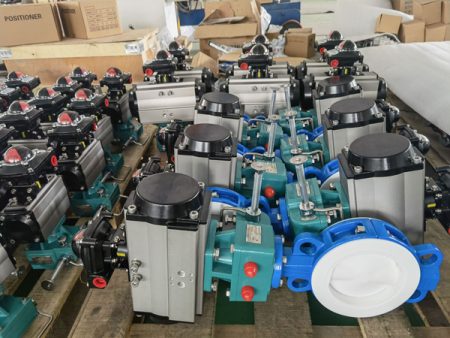
Beyond these general standards, there are also industry-specific certifications that address unique requirements and challenges of particular sectors. For instance, the National Sanitation Foundation (NSF) certification for valves used in food and beverage processing ensures compliance with strict hygiene and material requirements, while the Factory Mutual (FM) approval for fire protection applications guarantees that valves meet rigorous performance criteria for fire safety.In summary, industry standards and certifications serve as essential benchmarks for quality, safety, and reliability in the design, manufacturing, and operation of butterfly valves. By selecting valves that adhere to these established guidelines, end-users can have confidence in the product’s performance, durability, and compatibility with their specific application requirements, ultimately contributing to the overall success and efficiency of their projects and processes.
Importance of adhering to industry standards and certifications when selecting butterfly valve parts
Adhering to industry standards and certifications when selecting butterfly valve parts is of paramount importance, as it ensures the quality, safety, and reliability of the components and the overall valve assembly. Compliance with established guidelines, such as API, ISO, PED, or ASME standards, guarantees that the valve parts meet stringent requirements set forth by industry experts and regulatory bodies. This not only provides confidence in the product’s performance and suitability for specific applications but also helps mitigate potential risks associated with equipment failure, leakage, or accidents resulting from substandard components. Furthermore, using certified valve parts can contribute to the longevity and efficiency of the system, minimizing maintenance costs and downtime. In essence, adhering to industry standards and certifications when selecting butterfly valve parts is crucial to ensuring optimal performance, safety, and reliability, ultimately enhancing the success and cost-effectiveness of your project or process.
Common standards and certifications for butterfly valves (e.g., API, ASME, ISO, CE)
Common standards and certifications for butterfly valves, such as API, ASME, ISO, and CE, play a crucial role in ensuring the quality, safety, and reliability of these components across various industries. The American Petroleum Institute (API) standard, particularly API 609, outlines the general requirements for design, materials, and testing of butterfly valves, serving as a widely recognized benchmark for valve performance. The American Society of Mechanical Engineers (ASME) certification focuses on regulating the design, fabrication, and inspection of pressure equipment, including butterfly valves, guaranteeing their ability to safely withstand rated pressures and temperatures. The International Organization for Standardization (ISO) provides guidelines like ISO 5752, which specifies face-to-face dimensions for different types of valves, ensuring compatibility and interchangeability among components. The CE marking, representing conformity with the European Union’s regulations, including the Pressure Equipment Directive (PED), signifies that a butterfly valve adheres to the essential health, safety, and environmental protection requirements within the EU market. By choosing butterfly valves that comply with these established standards and certifications, end-users can be confident in the product’s performance, durability, and suitability for their specific application requirements, ultimately contributing to the overall success and efficiency of their projects and processes.
How these standards ensure quality, safety, and reliability
These industry standards and certifications, such as API, ASME, ISO, and CE, ensure quality, safety, and reliability by establishing stringent guidelines and requirements for the design, materials, fabrication, and testing of butterfly valves and other industrial components. By adhering to these benchmarks, manufacturers demonstrate their commitment to producing high-quality products that meet or exceed the expectations set forth by industry experts and regulatory bodies. These standards serve as a means of assessing and verifying the performance, durability, and compatibility of butterfly valves under various operating conditions, and they help minimize potential risks associated with equipment failure, leakage, or accidents resulting from substandard components. Furthermore, compliance with these guidelines fosters a culture of continuous improvement and innovation within the industry, as manufacturers strive to develop better, safer, and more efficient products in line with evolving standards. In essence, adherence to established industry standards and certifications guarantees that butterfly valves meet the highest levels of quality, safety, and reliability, providing end-users with confidence in the product’s performance and suitability for their specific application requirements.
Manufacturer reputation and support
Manufacturer reputation and support play a critical role in the selection and use of butterfly valves and other industrial components, as they can greatly influence the product’s quality, performance, and long-term reliability. A well-established and reputable manufacturer with a proven track record of producing high-quality valves demonstrates their commitment to meeting industry standards, adhering to certifications, and maintaining strong quality control processes throughout the manufacturing lifecycle. This not only instills confidence in the end-users regarding the valve’s suitability for their specific application requirements but also serves as an assurance of the manufacturer’s expertise and knowledge in the field.
Moreover, robust manufacturer support is essential for ensuring seamless integration, operation, and maintenance of butterfly valves within various systems and processes. By offering comprehensive technical assistance, training, and after-sales services, manufacturers can help end-users maximize the efficiency, performance, and longevity of their products. This support may include providing detailed documentation, troubleshooting guides, and spare parts availability, as well as access to expert engineers who can address complex challenges or offer guidance on best practices for installation, operation, and maintenance.
In essence, a strong manufacturer reputation and support contribute significantly to the overall success and cost-effectiveness of projects and processes involving butterfly valves. By selecting products from reputable manufacturers and leveraging their expertise and support, end-users can ensure optimal performance, reliability, and efficiency while minimizing potential risks and downtime associated with equipment failure or substandard components.

The importance of selecting a reputable manufacturer with a proven track record
The importance of selecting a reputable manufacturer with a proven track record cannot be overstated when it comes to choosing butterfly valves and other industrial components. A well-established manufacturer is more likely to adhere to industry standards, certifications, and maintain strict quality control processes throughout the manufacturing lifecycle, ensuring the product’s quality, performance, and reliability. By opting for a manufacturer with a solid reputation, end-users can have confidence in the valve’s suitability for their specific application requirements and benefit from the manufacturer’s expertise and experience in the field. Additionally, reputable manufacturers typically offer comprehensive technical support, training, and after-sales services, which can contribute to seamless integration, operation, and maintenance of the valves within various systems and processes. In summary, selecting a reputable manufacturer with a proven track record is crucial for ensuring optimal performance, reliability, and efficiency of butterfly valves, ultimately enhancing the overall success and cost-effectiveness of your project or process.
Factors to consider, such as product quality, availability, and after-sales support
When selecting butterfly valves and other industrial components, it is essential to consider factors such as product quality, availability, and after-sales support. Product quality is paramount, as it directly impacts the performance, reliability, and longevity of the valve within a specific application. By choosing components that meet or exceed industry standards and certifications, end-users can be confident in their investment and minimize potential risks associated with equipment failure or substandard parts. Availability is another crucial factor, as it ensures that the required valve components are readily accessible, avoiding delays in project timelines or costly downtime due to maintenance or replacements. Furthermore, after-sales support plays a significant role in the overall success and cost-effectiveness of a project or process. Comprehensive technical assistance, training, and access to expert engineers can help end-users maximize the efficiency, performance, and lifespan of their products, as well as address any challenges that may arise during installation, operation, or maintenance. In essence, considering these factors – product quality, availability, and after-sales support – is vital when selecting butterfly valves, as they contribute to the optimal performance, reliability, and cost-efficiency of your project or process.
Conclusion
In conclusion, selecting the right butterfly valve part is crucial for ensuring optimal performance, reliability, and efficiency within various industrial processes and applications. To make an informed decision, it is essential to consider several key aspects that contribute to the overall success and cost-effectiveness of your project or process.
- Industry Standards and Certifications: Adherence to established industry standards and certifications, such as API, ASME, ISO, and CE, guarantees that the butterfly valve parts meet stringent requirements set forth by experts and regulatory bodies. This ensures the product’s quality, safety, and reliability, minimizing the potential risks associated with equipment failure, leakage, or accidents resulting from substandard components.
- Manufacturer Reputation and Track Record: Choosing a reputable manufacturer with a proven track record in producing high-quality butterfly valves is vital. A well-established manufacturer is more likely to adhere to industry standards, maintain strict quality control processes, and offer comprehensive technical support, ensuring the product’s suitability for specific application requirements and contributing to its overall performance and longevity.
- Product Quality: Prioritizing product quality is essential, as it directly impacts the performance, reliability, and lifespan of the valve within a specific application. Opt for components that meet or exceed industry standards and certifications to ensure that you are investing in a reliable, high-performing product that can withstand the rigors of your specific process or application.
- Availability: Ensuring the availability of the required valve components is crucial for avoiding delays in project timelines or costly downtime due to maintenance or replacements. Choose a manufacturer or supplier that can provide the necessary parts promptly, without compromising on quality or adherence to industry standards.
- After-Sales Support: Comprehensive after-sales support, including technical assistance, training, and access to expert engineers, plays a significant role in maximizing the efficiency, performance, and lifespan of butterfly valve components. By selecting a manufacturer that offers robust support, end-users can address any challenges that may arise during installation, operation, or maintenance, ultimately contributing to the overall success and cost-effectiveness of their project or process.
In summary, selecting the right butterfly valve part involves considering a multitude of factors, including industry standards, manufacturer reputation, product quality, availability, and after-sales support. By carefully evaluating these aspects and making informed decisions, you can ensure optimal performance, reliability, and efficiency for your project or process, while mitigating potential risks and downtime associated with equipment failure or substandard components.
Recap the most important aspects of selecting a butterfly valve part
In recap, the most important aspects of selecting a butterfly valve part include adhering to industry standards and certifications, choosing a reputable manufacturer with a proven track record, prioritizing product quality, ensuring component availability, and seeking comprehensive after-sales support. By taking these factors into account, end-users can make informed decisions that contribute to the optimal performance, reliability, and efficiency of their projects or processes. Ultimately, considering these crucial aspects helps minimize potential risks and downtime associated with equipment failure or substandard components, ensuring the overall success and cost-effectiveness of your investment in butterfly valve parts.
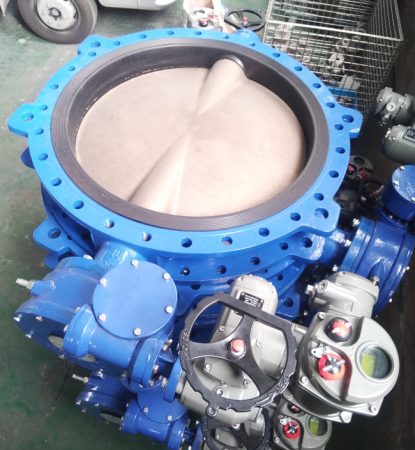
Emphasize the importance of considering all factors to ensure optimal performance and reliability in various applications
It is imperative to emphasize the importance of considering all factors – industry standards and certifications, manufacturer reputation, product quality, availability, and after-sales support – when selecting butterfly valve parts for various applications. By carefully evaluating these aspects, end-users can make informed decisions that contribute to optimal performance, reliability, and efficiency in their projects or processes. Each factor plays a critical role in mitigating potential risks and downtime associated with equipment failure or substandard components, ultimately ensuring the overall success and cost-effectiveness of your investment. In essence, taking a comprehensive approach and considering all relevant factors helps guarantee that the chosen butterfly valve parts meet the specific requirements of each application, leading to enhanced performance, reliability, and long-term satisfaction.



